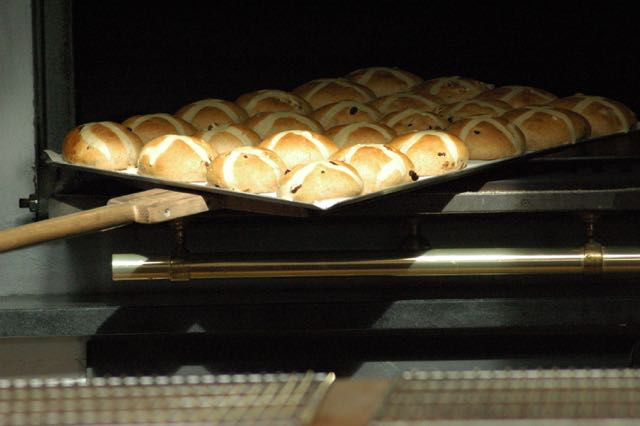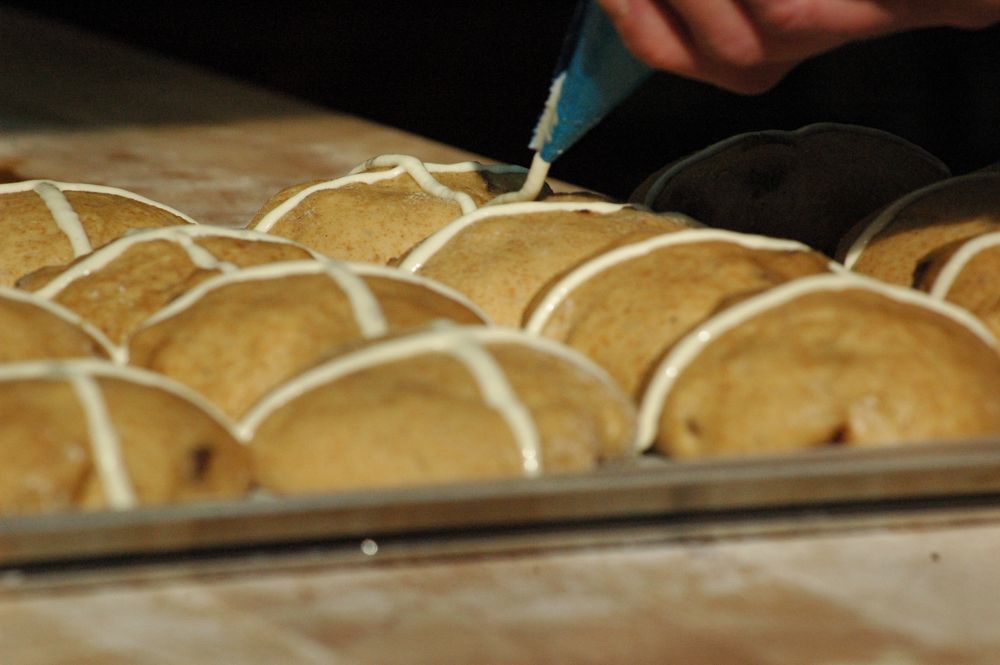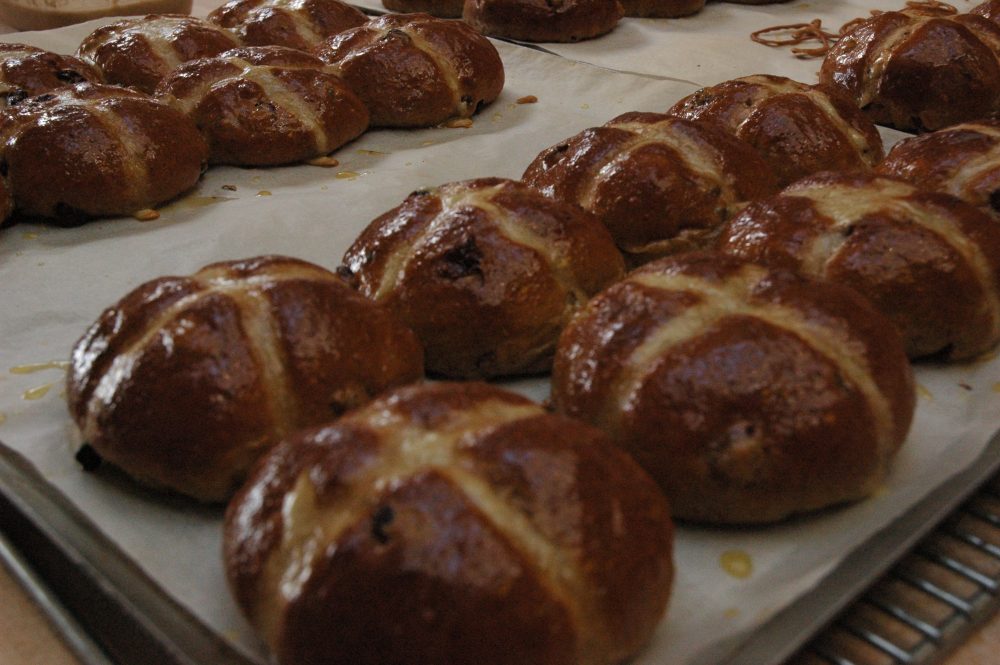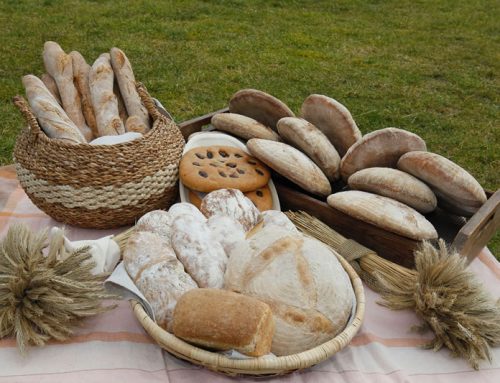This is a sourdough version of the Hot Cross Bun recipe from Bread Matters.
The process takes longer than the yeasted version, naturally, but the resulting buns are full of flavour, with a characteristic slightly chewy texture. Made with Scotland The Bread heritage wholemeal flour, they will taste all the better. The recipe below uses some white flour to make the buns a little lighter. The balance of flours can be adjusted to taste, bearing in mind that the more wholemeal used, the tastier – and more nutritious – the buns will be.
In medieval days it was common for bakers to place a cross on their loaves, perhaps to repel any evil spirits that might infect the bread and prevent it rising.
After the Reformation, such practices were frowned on as ‘popish’, but the cross remained as the symbol for the Easter bun.
Rich, spicy, fruited doughs were allowed at holidays or public burials and by the seventeenth century the hot cross bun was established fare for Maundy Thursday. Until quite recently, people ate hot cross buns on just this one day of the year. Needless to say, supermarket culture has diluted such seasonal pleasure and hot cross buns now appear on shelves as soon as Christmas is over, if not all year round.
Corporate marketing is adept at selling us re-heated morsels of our own history, for what is ‘One a penny, two a penny’ if not the original ‘buy one, get one free’?

To make 16 buns
12-24 hours before you want to make the Hot Cross Bun dough, soak a Fruit mixture and refresh your sourdough (if you haven’t got a sourdough starter on the go, see ‘Stage 1’ of the recipe here , but it takes a few days to build up from scratch).
Production Sourdough (16-hour)
| Scotland The Bread Wholemeal flour | 120g |
| White flour | 60g |
| Sourdough starter | 130g |
| Water (room temperature) | 110g |
| Total | 420g |
Refresh your old starter with flour and water as above. You can use all wholemeal flour if desired, but don’t use only white flour for this part because it’s lacking in the bioactive elements (natural yeasts and beneficial bacteria) that make a sourdough work well. Mix everything together into a smooth dough, then cover (a lidded tub is good) and leave in a cool place (not the fridge) to ferment.
[You can do a faster four-hour refreshment if you have a reasonably active starter. In this case, use 35°C water and leave the mix to ferment in a warm place.]
Fruit Mix
| Raisins | 100g |
| Sultanas | 100g |
| Stem or crystallised ginger, or candied peel | 70g |
| Fruit juice, water or spirit (e.g.rum) | 40g |
| Total | 310g |
Put everything into a bowl with a well-fitting lid or a strong polythene bag, tie its neck and swirl it around a bit so that the liquid comes into contact with all the dry ingredients. Do this a couple of times over the soaking period if possible.
Then, when the production sourdough is ready…
The Main Dough
| Production sourdough (from above) | 400g |
| White flour | 100g |
| Scotland The Bread Wholemeal flour | 200g |
| Butter (or olive oil) | 50g |
| Raw cane sugar | 50g |
| Mixed spice | 10g |
| Sea salt (reduce to 2 g if using salted butter) | 5g |
| Egg (two medium eggs) | 100g |
| Water | 100g |
| Fruit Mix (from above) | 300g |
| Total | 1315g |
See Method below
The Crossing Mix
| White flour (or sifted wholemeal) | 50g |
| Olive oil | 5g |
| Sourdough starter | 10g |
| Water (warm) | 50g |
| Total | 115g |
Mix all together and ferment for about four hours. The mixture should be bubbling a little and should be fairly runny.
Method
Add the flour, spice, salt, egg, sugar, butter & water (but not the fruit) to the production sourdough and mix until everything is combined well. Knead (or mix in a machine) gently for as long as it takes to develop a soft, fairly smooth dough (the smoothness will depend on the proportion of wholemeal flour in the mix). Scotland The Bread flour has a softer gluten that doesn’t require much kneading. Add a little extra water if the dough becomes too stiff. It must be very soft at this stage. The dough will be tacky on the surface because of the sugar and egg in the mix, so use water on your hands and the worktop to stop it sticking too much. If your dough feels too soft and sticky to handle, it is probably about right!
Put the kneaded dough in a bowl, cover well and leave it for 30 minutes or so. It won’t show many signs of rising in this time, but the gluten will relax which makes folding the fruit in much easier.
Stretch the dough gently out on a lightly floured surface into a rectangle about 25 cm (10”) x 20 cm (8”). Spread the soaked fruit mix over almost all the surface. Roll the dough up carefully, turn it through 90 degrees and roll it gently up again, taking care not to force the fruit through the surface (easier said than done).
Divide into pieces weighing about 80 grams each and, using a little flour on your hands and if necessary on the worktop, mould them into fairly tight, round buns and place them in accurate rows on a baking tray with a 2.5 cm (1”) gap between each bun. Remove any fruit exposed on the top of the rolls and tuck it underneath so that it doesn’t burn and become bitter. Prove until the buns are almost touching. This may take four or five hours, depending on the vigour of your sourdough. Be patient and remember that the natural sourdough yeasts are struggling with elements (butter, egg, spice, even the extra sugar) in the mix that make life difficult for them.
Place the fermenting crossing mix in a piping bag with a fairly fine nozzle, or cut a very small triangle (the opening should be no more than 3 mm across) from the corner of a stiff polythene bag and improvise your own piping bag.
Then pipe the crosses onto the buns as neatly as you can. Put the buns in the oven immediately after piping the crosses.
Bake at about 180°C/350°F for 10-15 minutes depending on your oven. Glaze generously as soon as the buns are out of the oven with a mixture of two parts warmed honey to one part whipping cream, thoroughly stirred.
Serve slightly warm and in the company of others.
© 2019 Bread Matters Ltd www.breadmatters.com





Hi Andrew,
I used to buy Village Bakery rye bread until the covid thingy caused them to stop baking.
Now I make my own (not always edible!). Was looking for tips which I got from Emily at Bells of Lazonby.
I have been a Naturopathic and Homeopathic practitioner most of my life (dob 1946) and discovered lots of healthful things along the way.
One of these was provided by Prof Jane Plant (The Plant Program) who discovered the cause of breast cancer while working in China. She was then able to cure herself of breast cancer by totally avoiding dairy products.
I have had a long fight against deafness which I traced to wheat while living in Spain.
We should meet up one day and exchange ideas!
Cheers,
Ken Green ND HD
Dear Andrew,
I am so happy to have found you and “thebread” It was totally by accident. I was actually searching for places to move in Scotland and looking at the surrounding areas came across the farm. I am a bread baker (home taught) the art of sourdough through many many hours, and not so tasty loaves. However, when I stumbled across an 1800’s “science in the kitchen” cookbook that changed my understanding about natural fermentation and yeast cultivation science, not just for the best risen loaf, but detailing the healthful benefits of naturally cultivated leaven. Your recipes seem to follow the guidelines I have learned and do create a natural, healthy, and tasty loaf. I am eager to try these hot cross buns.
Many thanks and blessed shared loaves.
Robin McGregor, Wilding
Hello Andrew, I did a course with you in Melmerby, I was (and still am) in a wheelchair. It was great. My daughter-in-law is gluten intolerant and my son, who is training to be a chef, has (in a novice way after I gave him your book Bread Matters has been making sourdough bread, which his wife can tolerate. He is hooked I am glad to say. Do you still run courses? Best wishes and keep up the good and much neaded work. Sue in Liverpool
Nice to hear from you Sue. I moved from Melmerby in 2009 to the Scottish Borders where I ran courses until 2017. I have now moved again to Fife, where I am close to Scotland The Bread HQ (www.scotlandthebread.org) where we research nutrient dense grains and mill them into wholemeal flour to supply community bakers. I’m afraid I don’t run courses now, except for a bit of ‘training the trainers’ work. Luckily there’s a younger generation of skilful and committed bakers coming through to whom I’m happy to pass the baguette. Best wishes, Andrew.
Thanks Andrew, also thank you for your wonderful little book Do Sourdough which I have had for some years now…changed our bread lives!
If I make the dough the night before, can I put it in the fridge overnight before baking…if so, at what stage should I stop and store till morning?
Many thanks
Amanda
Hello, Amanda. I would make the final dough with the fruit in, let it rest for an hour or so and then put it in the fridge. But…may I suggest a better way, which will result in edible buns sooner in the morning? Make the dough, divide it, shape into buns and line them up on a baking tray. Cover them loosely with a large poly bag or even carrier bag, trying to avoid any contact between the bag and the buns. This is to keep moisture in during a long proof. Move the tray to a cool place (around 10-12°C) if you have one and let the buns rise slowly overnight. My most recent batch, made and proved in a kitchen at about 18-20°C, took 7 hours to rise (the sourdough yeasts don’t relish all the spice and fruit), so an overnight proof at 12°C is quite possible. I hope this helps. Good baking! Andrew
Thanks Andrew couldn’t get my head round it as I thought I needed to land up with another swissroll to cut into portions to make bun balls. Hi
Looking forward to making these wonderful looking hot cross buns. Could you explain how the 90deg stage is done
Roll the dough up carefully, turn it through 90 degrees and roll it gently up again, taking care not to force the fruit through the surface (easier said than done).
Hello Pat. If you imagine that you have rolled/folded the fruit-covered dough piece up into a Swiss roll, and that this is lying roughly East-West in front of you (or Left-Right) on the table. The 90 degree instruction is simply to turn this whole lump of dough by 90 degrees so that it is now a strip running North-South. Then gently flatten it a little with your knuckle or the palm of your hand and roll it up again carefully. This is a simple way of distributing the fruit fairly evenly within the dough so that it isn’t all concentrated in one place, which would make the fruitiness of some buns greater than others. Don’t worry too much if the fruit breaks through the surface of the dough and leaves you with a sticky mess. Just rub flour on your hands and a little on the table so that you can divide the dough into individual buns and mould them up reasonably smoothly. The advantage of ending up with a smooth ball of fruity dough is that any fruit poking out or sitting on the surface is liable to get a bit charred during baking and this can detract from the eating quality a bit (although I usually pick off any burnt raisins etc just to check how burnt they are ;)).
Is there a way of making these without eggs? I need a vegan version. Thank you
There is, sadly, nothing quite like egg protein and albumen so any replacement is going to make for a slightly different texture. Gram (chick-pea) flour or fava bean flour are high in protein and a good ‘eggy’ colour, so you could try adding 60 g of one of those to the flour mix. The remaining 40 g of egg could be replaced by oil to increase the ‘richness’ of the dough. Some people find the flavour of virgin olive oil a bit strong, so rapeseed might be a good choice. You may need to up the water in the recipe a little in order to compensate for the extra flour. The dough should, in any case, be very soft – almost too sloppy to shape into rolls. That way, you’ll get a good rise and a toothsome bun.
I hope this helps. Let me know how you get on.
Andrew
Thank you so much for helping us keep the oven running, Andrew. They look delicious. Looking forward baking them. Happy baking from Spain. Nuria Cabellos 🙂
Thanks so much for this recipe. I can’t wait to try this updated version! Just in time for Easter!